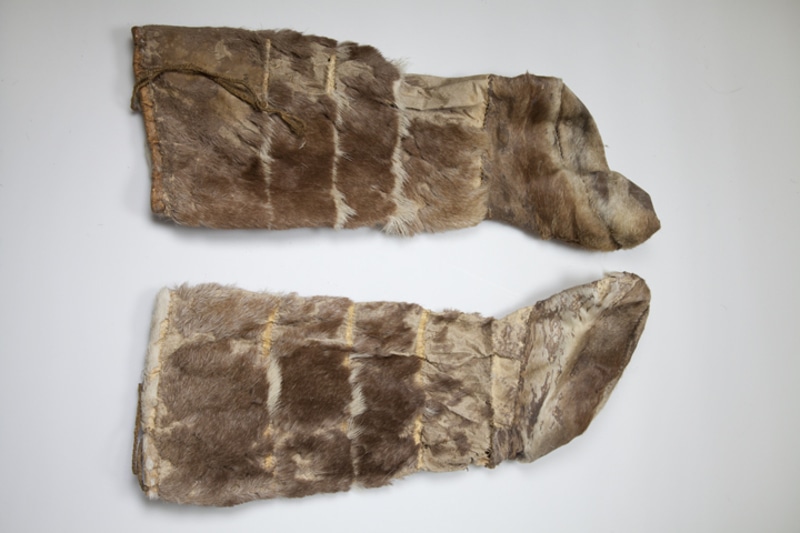boots Item Number: 1927.1734 . 176400 from the The Field Museum




Citations From Vanstone (1982) Article
« A pair of badly deteriorated winter boots is made of caribou skin with the hair on, taken from the region of the hock. The lower or foot portion of the boot consists of three pieces of skin, one fitting around the back and sewn down both sides of the foot, a second fitting over the instep and across the toes, and a third serving as the sole of the boot. The upper portion consists of four narrow, rectangular pieces of skin sewn together horizontally. The strips have been cut so that there is a fringe of white hair at the lower edge of each one. At the proximal end of the boot a narrow loop of tanned skin has been sewn to enclose a braided drawstring. This pair of boots appears to resemble somewhat the 'Teg-skin boots" described by Rogers (1967, pp. 58-59) as being worn by the Mistassini in spring for protection from melt water. However, the boots he describes usually reached only to the ankle while these clearly extend to the knees (fig. 30c). »
Vanstone, James W. "The Speck Collection of Montagnais Material Culture from the Lower St. Lawrence Drainage, Quebec." Fieldiana. Anthropology. New Series, No. 5 (October 29, 1982), p.17, fig 30c (p.58).
Translation Of Citations From Vanstone (1982) Article
« Une paire de bottes en très mauvais état est faite de peau de caribou qui comporte encore ses poils et qui provient de la partie du jarret. Le bas ou le pied de la botte est fait de trois pièces de peau, une faisant le tour de l’arrière et qui est cousue jusqu’au bas des deux côtés du pied, la seconde au-dessus de la cambrure du pied et par-dessus les orteils et la troisième servant de semelle pour la botte. La partie du haut est faite de quatre pièces de peau étroites et cousues ensemble horizontalement. Les bandes ont été coupées pour qu’il y ait une frange de poils blancs au bord inférieur de chacune. À l’extrémité proximale de la botte, on trouve une boucle étroite de peau tannée qui a été cousue pour joindre un cordon coulissant tressé. Cette paire de bottes ressemble en quelque sorte aux « bottes en peau de mouton » décrites par Rogers (1967, pp. 58-59) comme étant portées par les Mistassiniens au printemps pour se protéger de l’eau de neige qui a fondu. Cependant, les bottes qu’il a décrites montent d’habitude seulement jusqu’à la cheville, alors que celles-ci montent clairement jusqu’aux genoux (fig. 30c). »
Vanstone, James W. "The Speck Collection of Montagnais Material Culture from the Lower St. Lawrence Drainage, Quebec." Fieldiana. Anthropology. New Series, No. 5 (October 29, 1982), p.17, fig 30c (p.58).
Item History
- Made in Pekuakami, Lac Saint-Jean, Lake St. John, Labrador, Canada
Who
- Culture
- Ilnu, Montagnais and Innu
Where
- Holding Institution
- The Field Museum
- Made in
- Pekuakami, Lac Saint-Jean, Lake St. John, Labrador, Canada
Other
- Nom De L'objet
- Bottes
- Matériaux
- jarrets de chevreuil
- Ethnic Group
- Montagnais
- Collection
- Lake St. John Objects
- Provenience
- North America, Canada, Quebec, Labrador, Lake St. John